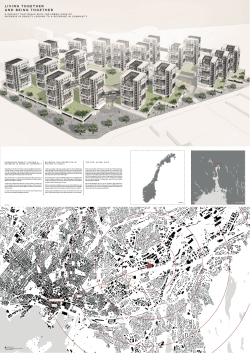
To the September 16th Field Excursion Guide
One-day field excursion in the Oslo region. By Professor Hans Arne Nakrem, Natural History Museum, University of Oslo. h.a.nakrem@nhm.uio.no The Oslo region (“Oslo Graben”) is famous for its Lower Palaeozoic sedimentary succession. These rocks are mainly composed of shales, sandstones and limestones, often rich in fossils. The Upper Palaeozoic rocks consist of Permian-?Triassic lavas as well as an up to 90 m thick Late Carbonifeorus fossil-poor siliciclastic unit. The excursion aims at visiting some of the Lower Palaeozoic units which show interesting sedimentary successions, fossils, as well as tectonic features. The Oslo Region (Oslofeltet) is a geological structure that varies in width from 40 to 70 km and extends approximately 115 km both north and south of Oslo, and covers an area of roughly 10 000 km2. It is bordered by Precambrian rocks to the east and west, and by the Caledonian nappes to the north. The Oslo Region also extends out into the fiord to the south (the Skagerrak Graben). The Lower Palaeozoic succession is approximately 2 500 m thick. The sedimentary package was folded and thrusted during the Late Silurian (Caledonian orogeny), as well as rifted during the Late Palaeozoic rifting phase. Local and regional thermal metamorphism is evident due to the Late Palaeozoic magmatic activity. During the Permo‐Carboniferous the Caledonian foreland sediments were down‐faulted in the Oslo Graben and covered by plateau lavas (basalts and rhomb porphyrs). Locally Permian intrusions are seen (batholiths, dykes, sills). Towards the end of the Permian, when magmatic and, perhaps also, tectonic events had finally ceased in the Oslo area, these processes moved westward where they continued into the Triassic. The climate during the transition from the Permian to the Triassic continued to be extremely arid warm. Localities to be visited (change in programme may, however, take place). Bygdøy, Huk, Oslo What to see: Lower-Middle Ordovician dark shales and massive limestones. Sedimentary rocks with fossils (trilobites, graptolites and orthocone cephalopods). Huk and Elnes formations. Caledonian compressional tectonics (thrusts and folding), Permian intrusions. Kalvøya, Bærum Upper Ordovician rocks, “incised valleys” with channel infill, corals, lithoclasts. Langøyene Formation. Some Permian dikes, with effect on surrounding rocks (metamorphosis). Slemmestad, Røyken Slemmestad centre. Precambrian basement overlain by Middle Cambrian conglomerate, alum shale and bituminous black limestone. Agnostid and paradoxid trilobites. Permian sill. Slemmestad football arena Middle Ordovician carbonate rocks (Huk Formation) with endoceratid cephalopods (hundreds), trace fossils, hardgrounds/omission surfaces, shales with trilobites. Bjørkåsholmen and Djuptrekkodden, Asker Lower and Middle Ordovician succession including the upper Alum Shale, Bjørkåsholmen, Tøyen, Huk and basal Elnes formations. Alternating dark/black shales, limestones and nodular limestones. Palynological data is published from these localities in Tongiorgi et al. (2003) who identified a microflora comprising 52 taxa of acritarchs from the Tøyen Formation (Tremadocian−Floian). The preservation is generally poor but most taxa were identified to the species level. It was shown that samples from the Hunneberg Stage contain a mixed cold-water (elements of the messaoudensistrifidum assemblage) and warmwater (Aryballomorpha-Athabascaella-Lua assemblage) microflora. Samples from the Billingen to lower Volkhov Stages contain species recorded from the Yangtze Platform (South China), which is considered to be part of the cold-water realm (or ‘Mediterranean Province’) located at high southern latitudes around the margin of Gondwana (Tongiorgi et al. 2003). However, because the samples from the Oslo area lack the typical cold to cool temperate-water indicators from Perigondwana, such as Arbusculidium, Aureotesta, Coryphidium, Striatorheca and Vavrdovella, the flora was regarded as compatible with a mid-latitude position of Baltica during the Floian–Darriwilian. Presumed ocean currents caused a climate warmer than in China at this time. In contrast, the late Dapingian to early Darriwilian (late Volkhov to early Kunda) Baltic microflora belongs neither to the cold-water Perigondwana realm nor to a less well-defined warm-water realm. Evolution in the composition of phytoplankton from a middle Floian ‘Mediterranean microflora’ to an early Darriwilian ‘Baltic microflora’ occurs on both palaeocontinents (South China and Baltica). This implies a reciprocal exchange within a mid-latitude realm controlled more by the pattern of subtropical oceanic gyres rather than just latitudinal position. A similar evolution of acritarch assemblages is also noted across the East European Platform in Russia and Poland. Asker, Holmenskjæret Upper Ordovician carbonate rocks (with Holocene glacial straitions), various fossils, incl, algae, Palaeoporella. Langøyene Formation. Further reading Dorning, K.J. & Aldridge, K.J., 1982. A preliminary investigation of palynological assemblages from the Early Silurian of Ringerike. Palaeontological contributions from the University of Oslo 278, 105-108. Nakrem, H.A. & Rasmussen, J.A. 2013. Oslo district, Norway. In: M. Calner, P. Ahlberg, O. Lehnert & M. Erlström (eds.): The Lower Palaeozoic of southern Sweden and the Oslo Region, Norway. Field Guide for the 3rd Annual Meeting of the IGCP project 591. Sveriges geologiska undersökning Rapporter och meddelanden 133, 58–85 (+references). Smelror, M. 1987. Early Silurian acritarchs and prasinophycean algae from the Ringerike District, Oslo Region (Norway). Review of Palaeobotany and Palynology 52, pp.137-159 Tongiorgi, M., Bruton, D.L. & Di Milia, A., 2003: Taxonomic composition and palaeobiogeographic significance of the acritarch assemblages from the Tremadoc-Arenig (Hunneberg, Billingen and lower Volkhov Stages) of the Oslo Region. Bollettino della Societa Paleontologica Italiana 42, 205−224. Oslo Region, simplyfied geological map Oslo Region stratigraphy Slemmestad centrum, M. Cambrian on Proterozoic basement Bygdøy, Huk Slemmestad football arena Slemmestad football arena, orthocones
© Copyright 2025















